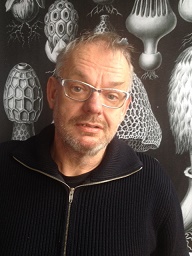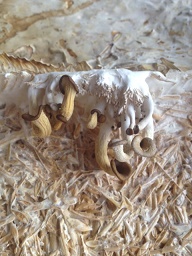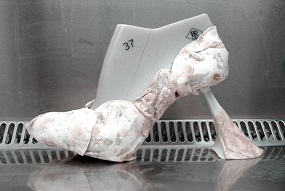The Myco Design Lab of the international art foundation Mediamatic based in Amsterdam, links the worlds of industry and art. This program is about everything we can do with mycelium, the predominantly underground fungi threads or hyphae that form the vegetative part of fungi. The Myco Design Lab researches, grows, changes, shows, eats, cooks and forms mycelium and all products that can be made of that material.
Willem Velthoven

Interest for mycelium as a construction material is relatively young. The pioneer in this area is Ecovative Design, the subject of an earlier article. In the Myco Design Lab, Mediamatic makes a crossover to the world of art. Like many of Mediamatic’s programs, the Lab has an open structure, in which artists can take part with projects of their own. It is part of the broader Bio Industry Program, that researchers the opportunities of biobased resources for design, science and art. For instance, the foundation recently ran the major project The Tosti Factory, in which all steps towards the production of toasted ham and cheese sandwiches were concentrated in one single area. Aquaponics (the co-breeding of fishes and water plants) is another important activity. But right now, the Myco Design Lab is the largest program within Bio Industry. The web page of this program started three years ago, now contains 89 projects.
Art and experiment

‘We research new combinations of materials and fungi,’ says Willem Velthoven, Mediamatic’s executive officer. ‘As a substrate we can use straw, or even cheaper, rice or wheat chaff. We experiment with cocoa bean shells, available in large quantities in Amsterdam, the world’s main cocoa harbour. And the jute bags in which the cocoa beans arrive in the harbour. We research how different fungi grow on these substrates. And what we can do with them. Recently, we started to grow pure mycelium, without a substrate. It is soft and strong, it resembles silk. Or we run into leather like materials. Treatment with acetic acid will produce materials that resemble Bakelite.’
Mediamatic has been active for decades and started out doing many IT and related projects, under the wonderful name of Doors of Perception. It now mainly runs projects inspired by living nature, the Bio Industry, of which the Myco Design Lab is a part. Everything they do is low-key and cheap. ‘We just try, we do not know where that will take us.’ For instance, Mediamatic will use these materials itself, for the restauration and reconstruction of the run-down office building to which it has moved a little while ago. It develops myco tiles that it will use as an insulation material for the roof of two adjacent sheds. ‘We could buy fossil-based materials in the building supermarket around the corner, we could finish roof insulation within a week. But we do it our way.’ The tiles we were shown looked quite fit for the job already, though a bit brittle.
The Myco Design Lab has many branches

On this theme, Mediamatic cooperates with scientists. The most important scientific connection for Myco Design Lab is Utrecht University, in particular its researcher Han Wösten. He specialises on the Schizophyllum commune, a kind of fungus very common around the world. Wösten has unravelled the genome of this little mushroom; and that offers the opportunity to myco designers to use it as the basis of their sketch book. Another important connection is Peter Oei, program director of the Dutch Innovative Horticulture Foundation SIGN. In his scarce free time he specialises in growing exotic mushrooms like shiitake and king oyster mushroom. He is the author of the book ‘Mushroom Cultivation’, that recently had its third update.
There is a growing number of opportunities for designers using myco materials. We saw leather-like materials used for designing shoes. Other artists design textiles. Mushrooms for consumption attract a lot of attention these days, just like related themes as beer experiments. The forms and expressions of the Myco Design Lab are endless. We will hear much about in the future.
Author
Diederik van der Hoeven
Source
Supplier
Ecovative Design LLC
Mediamatic.net - Myco Design Lab
SIGN Horticulture (NL)
University of Utrecht
Share
Renewable Carbon News – Daily Newsletter
Subscribe to our daily email newsletter – the world's leading newsletter on renewable materials and chemicals










